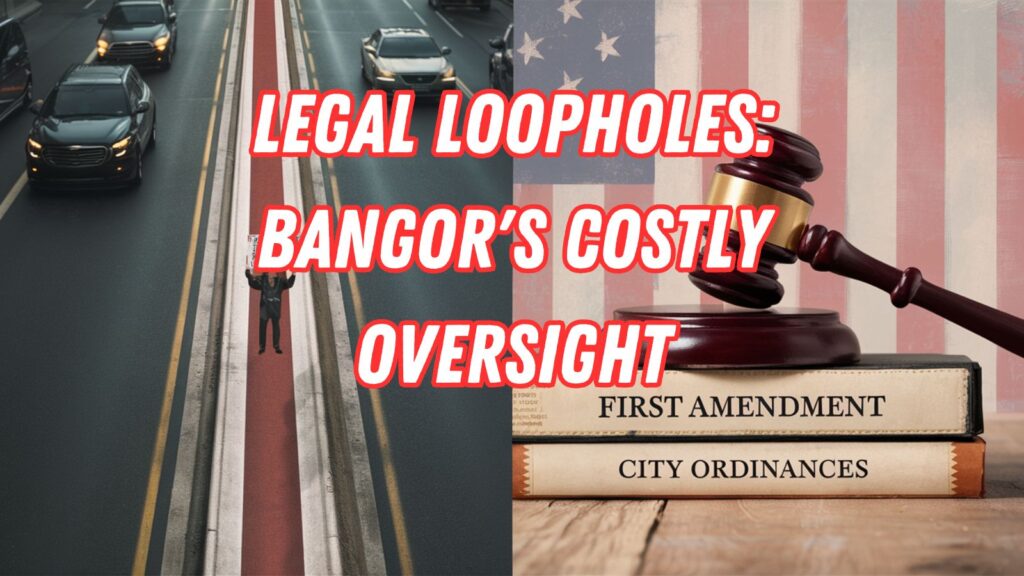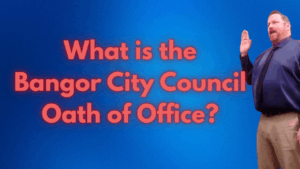
This week the Bangor City Council approved an ordinance amendment to Chapter 172, Loitering.
It shall also be unlawful for any person to loiter, either alone or with others, on medians less than six
Bangor City Council Order 24-180, Passed June 24, 2024, by 5-2 vote.
feet wide in high-volume or high-speed traffic areas, due to safety concerns.
This article is about the legal realities of this law.
This article isn’t about the moral debate surrounding this ordinance. Some feel it’s been long overdue. Others feel it unfairly discriminates against a vulnerable population. I’m not debating either of those points in this article. This article is not about the city’s goal with this law. This article is about the poor execution, why Bangor is going to get sued, lose the case, and cost ALL Bangor residents money.
What do you mean, cost residents money?
In 2015 the City of Portland was court ordered to hand over $175,000 to the ACLU for their legal fees, after their failed bid to defend their ordinance. This doesn’t include all of the money the city had to spend in salary, material, and other legal expenses during the case.
When the city of Bangor is sued for this ordinance, their costs will be higher. I’m conservatively estimating $250,000 at least. Based on a calculation made during the May 29th budget workshop meeting, we can now estimate the average taxpayer will be chipping in $20 to enroll the City Council in an expensive First Amendment lesson.
Bangor will be sued, and the city will lose.
It’s a foregone conclusion. Court opinions in previous cases like ours tell us so. There is only one scenario that I can see that Bangor comes out on top: the city has the most incredible luck and draws a judge that doesn’t believe in precedent when deciding cases and the plaintiff in the case opts not to appeal.
Let’s break down why the city will lose.
The City Solicitor’s Memo
Enough minds on Council were made up on the premise of the law (public safety) that any remaining debate to be had was on the constitutionality of the law. The ACLU announced their belief that the law is unconstitutional through the media, and that was enough to prompt the Bangor City Solicitor David Szewczyk to write a memo in an attempt to ease Councilor’s concerns. It was that memo that steeled the spines of enough Councilors to see this ordinance through to passage. In hindsight they’re going to wish they got a second opinion.
The court’s roadmap and how Bangor stacks up
Municipalities across the United States have enacted laws to ban people from loitering. And like turning on the Bat Signal for lawyers, an organization with a legal team swoops in, finds an aggrieved individual and files a lawsuit on their behalf. Analyzing the multitude of cases has resulted in a roadmap that governments can follow that will give them the best chance of ensuring their law will stand up in court.
Content Neutral
Courts have consistently held that content neutrality is a cornerstone of First Amendment protections. When evaluating speech restrictions in public forums, judges first determine whether the law in question discriminates based on the content of the speech. If a law is found to be content-based, it’s subject to strict scrutiny – the highest level of judicial review, which few laws survive. Content-neutral regulations, on the other hand, face a less rigorous standard of review.
This is why the Bangor City Solicitor’s memo emphasizes that the City’s ordinance is content neutral. However, a closer examination reveals significant flaws in this claim, stemming largely from the city’s inexplicable decision to frame this as a “loitering” issue.
Bangor hastily shoehorned this law into Chapter §174, titled “Loitering”. This approach stands in stark contrast to other municipalities that have successfully defended similar ordinances. For instance, Dallas, Texas, which prevailed in Waggoner v City of Dallas, gave their law its own section and used more precise language:
A person commits an offense if the person stands or walks on a median that measures six feet or less in width, in areas where no median exists for roadways designated as divided roadways, or in an area designated as a clear zone.
The Dallas City Code > SEC. 28-61.1. STANDING AND WALKING IN CERTAIN AREAS PROHIBITED.
By focusing on specific actions (standing or walking) rather than the vague concept of “loitering,” Dallas created a more content-neutral ordinance that withstood judicial scrutiny.
Bangor, on the other hand, relies on its existing definition of loitering:
Remaining idle in essentially one location, and shall include the concept of spending time idly, to be dilatory, to linger, to stay, to saunter, to delay and to stand around and shall also include the colloquial expression “hanging around.”
Bangor City Code, Chapter 174 Loitering
This definition creates a significant loophole that undermines the ordinance’s claim to content neutrality. Consider the act of placing a political sign on a median. One could quickly step onto a median, plant a sign, and step off in a matter of seconds. This brief action wouldn’t meet the city’s definition of loitering. Moreover, local election laws often permit political signs on medians.
This creates a paradoxical situation where:
- Brief activities like placing political signs would be allowed under the ordinance.
- Longer-duration activities like holding a sign, panhandling, or protesting would be prohibited.
The result? An ordinance that claims to be content-neutral inadvertently allows some forms of speech while prohibiting others based on the duration of the activity rather than its content. This disparity could be seen as a form of de facto content-based regulation, which courts typically view with high scrutiny.
This loophole not only undermines the city’s claim of content neutrality but also opens the door to potential selective enforcement issues. It’s a prime example of how seemingly neutral language can have unintended consequences that infringe on First Amendment rights.
Had Bangor followed Dallas’s example and crafted a separate ordinance prohibiting specific actions like standing or walking on narrow medians, they might have had a stronger claim to content neutrality. Instead, by relying on the vague and broadly defined concept of “loitering,” they’ve created an ordinance that may inadvertently discriminate based on the content and duration of expressive activities.
This flaw in the ordinance’s construction significantly weakens Bangor’s legal position. Courts are likely to view this discrepancy as a form of content-based regulation, subjecting the ordinance to strict scrutiny – a test it would likely fail. It’s a stark reminder of the importance of precise language and careful consideration of unintended consequences when crafting laws that impact First Amendment rights.
Public Safety
When it comes to justifying public safety concerns, Waggoner v. City of Dallas provides a crucial precedent for Bangor’s situation. In this case, Dallas successfully defended its ordinance prohibiting standing or walking on certain medians, offering a roadmap for how cities can craft legally defensible restrictions.
The key to Dallas’s success was their thorough approach to data collection and analysis. Before enacting their ordinance, the city conducted a comprehensive two-year study. This wasn’t just a cursory glance at accident reports; it was a deep dive into the specific safety issues related to median use.
If Bangor has followed Dallas’s lead, they should have:
- Detailed accident data involving pedestrians on medians in the city
- Traffic flow analysis for the high-volume and high-speed areas mentioned in the ordinance
- Studies on how median width correlates with pedestrian safety in Bangor’s specific context
However, the city’s justification is based primarily on anecdotal evidence and general safety concerns. The bar set by Waggoner is high, but it’s also clear: cities need to back up their safety claims with solid, relevant data.
It’s worth noting that the court in Waggoner didn’t require the city to prove that accidents had actually occurred on every median covered by the ordinance. Instead, they were satisfied that Dallas had demonstrated a general safety risk associated with pedestrian use of narrow medians in busy areas. But crucially, this conclusion was backed by comprehensive data and analysis.
So, the $250,000 question: Has Bangor done its homework? No, they haven’t. They’re going to find themselves scrambling to justify their ordinance in court, potentially facing the same expensive lesson that Portland learned in 2015.
Remember, it’s not just about having safety concerns – it’s about proving those concerns are real, specific to the areas covered by the ordinance, and directly addressed by the restrictions imposed. As the Supreme Court stated in Turner Broadcasting System, Inc. v. FCC, the government “must do more than simply ‘posit the existence of the disease sought to be cured.'” It must demonstrate that the recited harms are real, not merely conjectural, and that the regulation will in fact alleviate these harms in a direct and material way.
Without this level of evidence, Bangor’s ordinance may be standing on a median as precarious as the ones they’re trying to regulate. The city needs to show it’s not just positing a disease, but that it has diagnosed it accurately and prescribed an appropriate remedy. It does not appear they will be able to do that and they’ve scheduled all of us for a costly legal checkup.
Narrow Tailoring
Another crucial aspect courts look at is whether the ordinance is “narrowly tailored” to achieve its stated goal. In other words, does it restrict more speech than necessary to address the safety concerns?
Bangor’s ordinance applies to all medians less than six feet wide in “high-volume or high-speed traffic areas.” This vague wording could be problematic. What exactly constitutes a “high-volume” or “high-speed” area? Without clear definitions, this could be seen as overly broad and open to selective enforcement.
Compare this to Dallas, which specified exact roadway designations where their ordinance applied. This level of precision is what courts tend to favor when evaluating narrow tailoring.
Alternative Channels of Communication
Finally, courts consider whether the ordinance leaves open ample alternative channels for communication. This is where Bangor might face its biggest challenge.
By banning loitering on all narrow medians in busy areas, the city has effectively eliminated one of the most visible and accessible locations for various forms of expression, including panhandling, political demonstrations, and charity fundraising.
Bangor’s attempt to justify its new median ordinance by pointing to alternative channels of communication is severely undercut by its existing loitering laws. The combination of these ordinances creates a regulatory environment that leaves little room for constitutionally protected forms of public expression.
Let’s break down the key issues:
- Overly Broad Definition of Loitering: Bangor defines loitering as “remaining idle in essentially one location,” including “spending time idly, to be dilatory, to linger, to stay, to saunter, to delay and to stand around.” This definition is so broad that it could encompass nearly any form of stationary expressive activity in public spaces.
- Extensive Restrictions in Public Places: The ordinance applies to any “public place,” defined broadly to include not just streets and sidewalks, but also “any place to which the general public has access,” including areas in front of businesses. This leaves virtually no public space exempt from these restrictions.
- Prohibition on Obstruction: The ordinance forbids not just actual obstruction, but anything that might “hinder or impede the free and uninterrupted passage” of others. This could potentially apply to someone simply standing still while holding a sign or peacefully asking for donations, even if passersby can easily walk around them.
- Interference with Business: The law also prohibits any act that interferes with “the free and uninterrupted use of property or to any business.” This could be interpreted to restrict a wide range of expressive activities near businesses, such as protests or leafleting.
- Mandatory Dispersal: Perhaps most troublingly, the ordinance requires police to order anyone “causing or committing” these broadly defined conditions to “move on or disperse.” This gives law enforcement wide discretion to shut down expressive activities.
When viewed alongside the new median ordinance, it becomes clear that Bangor has created a regulatory scheme that leaves almost no public space available for certain forms of protected speech. Medians are now off-limits, and sidewalks and other public areas are subject to restrictions so broad that they could prohibit even peaceful, non-obstructive expressive activities.
This comprehensive approach to restricting public expression goes far beyond what courts have typically allowed under the “ample alternative channels” doctrine. In cases like Cutting v. City of Portland, courts have recognized the unique value of certain public spaces for communication. Bangor’s ordinances, taken together, don’t just eliminate one type of space – they potentially restrict expression across all public areas.
In defending its median ordinance, Bangor will likely struggle to argue that ample alternative channels remain when their own loitering laws place such severe restrictions on the use of sidewalks and other public spaces. The city has effectively painted itself into a legal corner, creating a situation where constitutionally protected activities like peaceful protesting, leafleting, or even quietly holding a sign could potentially violate city ordinances regardless of where they occur.
This overreach in regulating public spaces significantly weakens Bangor’s legal position. Courts are likely to view this combination of ordinances with skepticism, seeing it as an overly broad restriction on public expression that fails to leave open meaningful alternative channels for communication. As such, Bangor may find itself facing an uphill battle in defending not just its new median ordinance, but its entire approach to regulating speech in public spaces.
Conclusion
In light of these issues, it’s hard to see how Bangor’s ordinance will survive judicial scrutiny. The vague wording, potential lack of content neutrality, and broad restrictions all work against the city’s case.
What’s particularly frustrating is that there were clear examples of how to craft a more legally defensible ordinance. Cities like Dallas have provided a blueprint, yet Bangor seems to have ignored these lessons.
The result? Bangor taxpayers are likely to foot a hefty legal bill for an ordinance that’s almost certainly doomed to fail. It’s a stark reminder of the importance of careful legal drafting and the high cost of ignoring established precedent.
As we wait for the inevitable lawsuit, one can only hope that this expensive lesson will encourage more thoughtful policymaking in the future. But for now, Bangor residents should brace themselves for the impending legal battle and its associated costs.







